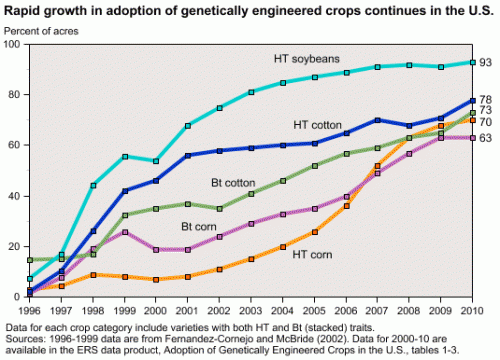My monthly Food Matters column in the San Francisco Chronicle answers readers’ questions and these tend to be about nutrition rather than food politics. Today’s column is about diets aimed at controlling the amount of acid excreted in urine:
Low acid diet may not prevent bone loss
Q: I’ve just read “Building Bone Vitality: A Revolutionary Plan to Prevent Bone Loss and Reverse Osteoporosis,” by Amy Lanou and Michael Castleman.
The writers contend that a high acid diet causes bone loss and other negative health outcomes. The book is so well documented and the theory so logically explained that I find it compelling.
However, I am not a scientist and would appreciate your opinion.
A: Ordinarily I would not bother to read a book with the word “Revolutionary” in its title. In diet books, “revolutionary” invariably means using a grain of scientific truth to construct a dietary theory that contradicts current thinking but cannot be proven by current research.
But two readers asked about this book and I was curious about it for another reason. Last year, I gave a talk at a spa where I was seated at dinner next to a couple who announced that they were following a low-acid diet. To my amazement, they excused themselves during the meal to measure the pH of their urine.
Stay with me: pH is a measure of acidity or hydrogen ion concentration. pH 7 is neutral. Above 7 is basic or alkaline. Below 7 is acidic.
I could not believe that anyone would bother to measure urine pH, let alone leave dinner to do so. The pH of blood is tightly regulated and must stay within a slightly alkaline range of 7.36 to 7.4. Bicarbonate buffering systems keep it that way, and excreting excess acid is exactly what the kidney is supposed to do.
The authors are proponents of vegan diets. Here, they argue that small increases in blood acidity cause calcium to be leached from bones to help neutralize it. Over time, these small losses weaken bones and lead to osteoporosis.
Adding calcium to the diet, they claim, is not enough to replace the losses. They parse the results of 1,200 research studies to argue that dairy foods cannot protect against osteoporosis. Instead, low acidity – meaning too much meat – provides the best current explanation for worldwide rates of osteoporosis.
The authors provide an entertaining list of the acid-producing potential of more than 100 foods. As they put it, “flesh foods”- beef, chicken and fish – produce the most acid, with grains coming in second.
Dairy, oddly, is low-acid, except for cheeses. They produce the most. Four ounces of Parmesan, for example, yield 34 milliequivalents (mEq). Compare this to 4 ounces of trout (11 mEq), beef (8), cornflakes (6) or yogurt (1).
Acidity depends largely, but not exclusively, on protein content. All proteins form acid, but “flesh” proteins yield more. They contain more sulfurous amino acids than do plant proteins. Meat and grains also have more acid-forming phosphates.
In contrast, fruits and vegetables contain loads of alkali-producing potassium and magnesium. They have minus numbers: apples (-2 mEq), potatoes and cauliflower (-4), and avocados (-8), with the alkali prize going to raisins (-21).
To prove this theory, research must demonstrate four things: foods have differential effects on urine pH, acid-producing diets cause calcium to be excreted, calcium excretion reflects loss of calcium from bones, and acid-induced calcium losses lead to osteoporosis.
Research easily confirms that animal foods and grains produce more acid than do fruits and vegetables and cause calcium to be excreted in urine. Evidence for everything else, however, is much less certain. Although some studies find bone losses with high-acid diets, a recent “meta-analysis” published in the Journal of Bone Mineral Research concluded that urine calcium does not reflect bone calcium. It found little justification for the idea that alkaline foods prevent bone calcium losses.
Kidney specialists agree. I asked Dr. Jerome Lowenstein, author of “Acids and Basics: A Guide to Understanding Acid-Base Disorders,” for comment. He says bone calcium is involved in maintaining normal blood pH, but so are many other factors.
Normal kidneys maintain normal blood pH over a very wide range of diets. Diet may affect acid-base balance in people with damaged or diseased kidneys, but matters less to people with normal kidneys. Bone losses do occur in kidney disease but not because bone serves as an acid buffer.
“If it did, patients with advanced kidney disease would become invertebrate within a couple of years,” he says.
How to make sense of this? To prevent osteoporosis, the authors promote a vegan diet based on low-acid fruits, vegetables and beans, with no or minimal acid-producing meat, poultry, fish, eggs, cheese and grains.
Revolutionary? Hardly.
Last month’s report from the 2010 Dietary Guidelines Advisory Committee called for a shift in food intake patterns to a more plant-based diet, one with more vegetables, beans, fruits, whole grains, nuts, seeds, seafood and low-fat milk products, and only moderate amounts of lean meats, poultry and eggs.
Eat healthfully, and you automatically eat low-acid.
So: eat vegetables with your meat, forget about pH testing, and enjoy your dinner.



